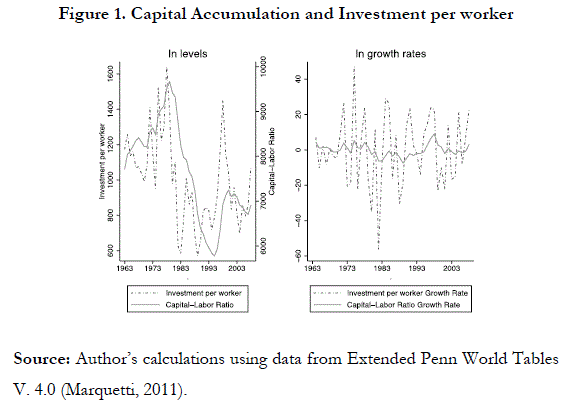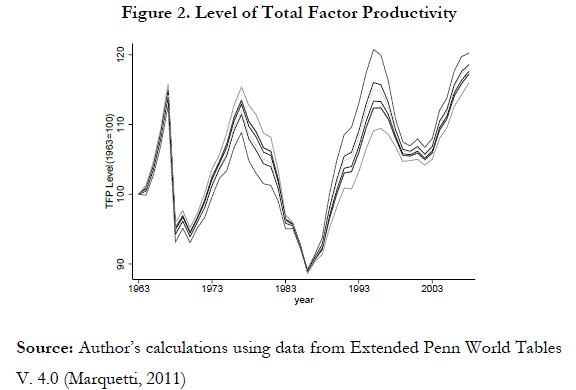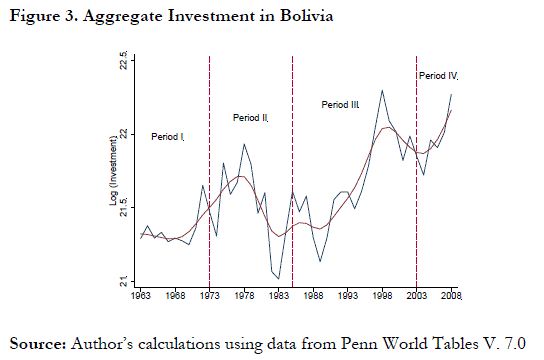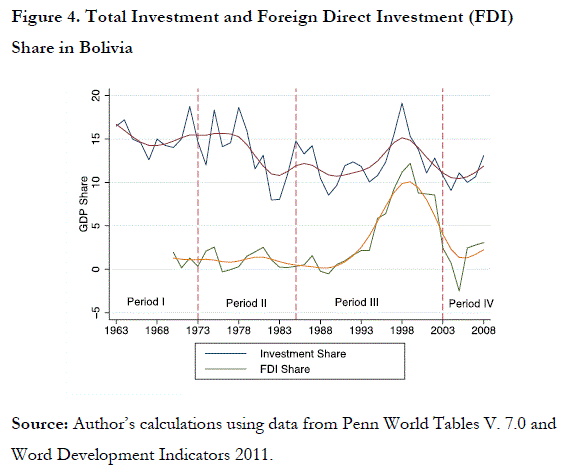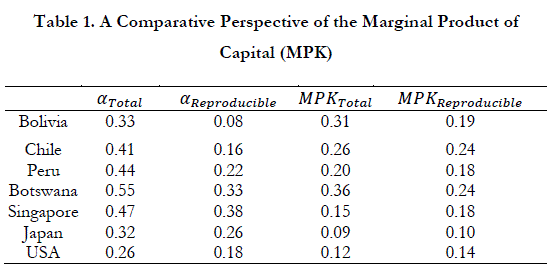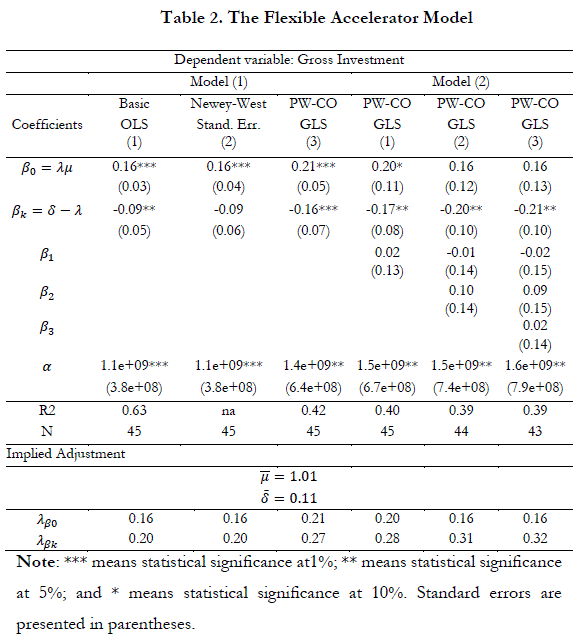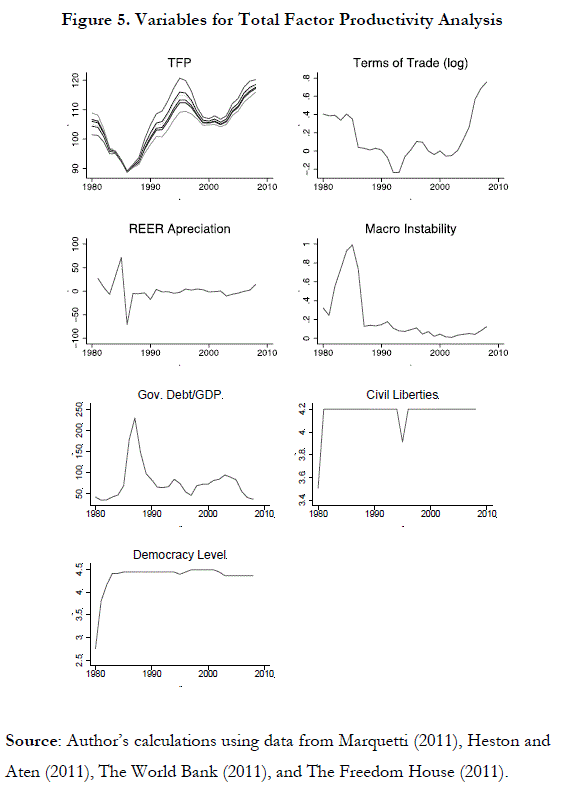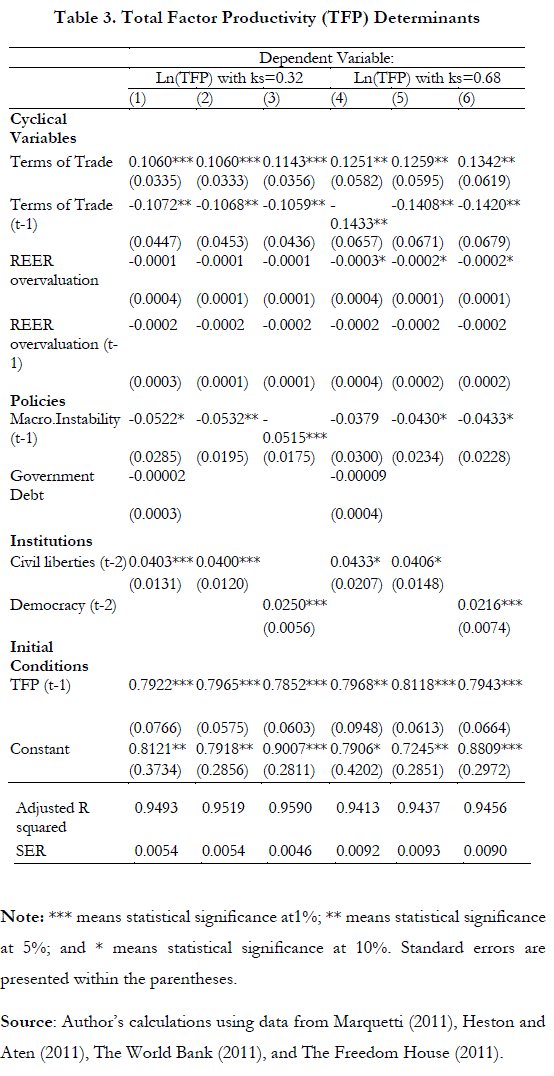Services on Demand
Journal
Article
Indicators
-
 Cited by SciELO
Cited by SciELO -
 Access statistics
Access statistics
Related links
-
 Similars in
SciELO
Similars in
SciELO
Share
Economía Coyuntural
Print version ISSN 2415-0622On-line version ISSN 2415-0630
Revista de coyuntura y perspectiva vol.3 no.4 Santa Cruz de la Sierra Dec. 2018
ARTICLE ACADEMIC
Investment Constraints and Productivity Cycles
in Bolivia
Restricciones a la Inversión y Ciclos de Productividad
en Bolivia
Carlos Mendez-Guerraα
α Associate Professor, Graduate School of International Development, Nagoya University, Japan.
Email: carlos@gsid.nagoya-u.ac.jp Website: https://carlos-mendez.rbind.io
Recepción: 27/11/2018 Aceptación: 02/05/2019
Abstract
Bolivia has suffered from a series of investment constraints and negative productivity cycles in the last half-century. In this context, this article first presents suggestive empirical evidence that physical capital accumulation has been constrained by high volatility in investment per worker, low marginal product of capital, and high adjustment costs. Next, the article presents evidence about the cyclical behavior of Bolivia’s total factor productivity (TFP) during the 1980-2008 period. As expected, the cyclical dynamics of TFP are shaped by cyclical variables such as terms of trade and fluctuations in the real exchange. However, economic policy variables (such as macroeconomic stabilization and external debt management), institutional variables (such as democracy and civil rights) and initial conditions also appear to be significant when explaining the behavior of Bolivia’s TFP.
Keywords: Investment, productivity, capital accumulation, Bolivia.
Resumen
Bolivia ha sufrido una serie de restricciones a la inversión y ciclos negativos de productividad en el último medio siglo. En este contexto, este artículo primero presenta evidencia empírica que sugiere que la acumulación de capital físico ha sido restringida por la alta volatilidad de la inversión por trabajador, el bajo producto marginal del capital, y los altos costos de ajuste de la inversión. Seguidamente, el artículo presenta evidencia empírica sobre el comportamiento cíclico de la productividad total de factores (PTF) durante el periodo 1980-2008. Como se esperaba, la dinámica cíclica de la PTF ha sido afectada por variables cíclicas como ser las fluctuaciones en los términos de intercambio y el tipo de cambio real. Sin embargo, variables de política económica (como la estabilización macroeconómica y la administración de la deuda externa), variables institucionales (como la democracia y los derechos civiles), y las condiciones iniciales son también significativas al momento de explicar el comportamiento de la PTF en Bolivia.
Palabras clave: Inversión, productividad, acumulación de capital, Bolivia.
Clasificación JEL: O40, 047.
1. Introduction
It is well known that physical capital accumulation and productivity improvements are two of the most proximate determinants of economic growth. In this context, much of the current research in development economics has to do with the underlying sources of capital accumulation and productivity growth. Figure 1 shows the behavior of physical capital accumulation and one of its underlying sources: investment. This figure suggests that physical capital accumulation appears to be constrained by largely unstable changes in investment. Figure 2 shows the behavior of the other proximate determinant of economic growth: total factor productivity (TFP). The figure emphasizes thateven in levelsproductivity shows a clear cyclical behavior.
Given these empirical regularities, this article aims to provide an answer to the following two questions:
1. What factors can help explain the capital accumulation constrains in Bolivia?
2. What factors can help explain the cyclical behavior of total factor productivity in Bolivia?
The literature on the determinants of capital accumulation and investment constraints in Bolivia typically highlights how political instability, risk of expropiation, and economic crises are to a large extent responsible for high volatility of investment, low returns of capital, and lack of physical capital accumulation (Calvo, 2006; Jemio, 2008; Kehoe, Machicado, and Peres-Cajías, 2019). Furthermore, since fiscal policy in Bolivia is highly procyclical (Gonzáles-Zuazo and Molina-Fernández, 2017), the country has not been able to stabilize both the volatility of investment and the cyclicality of the overall economy (Lordemann, Rubín de Celis, and Villegas-Quino, 2011). Also, it has been previously documented that the investment environment in Bolivia is very sensitive to external shocks (Villegas-Quino et. al, 2011).
The literature on the determinants of total factor productivity in Bolivia is relatively much more limited than that of investment. Most econometric studies have focused on the determinants of economic growth (Humerez and Dorado, 2009; Humerez, 2017; Mendieta and Martin, 2009; among others). One recent exception is the work of Machicado (2018). In this study, the author follows the econometric specification of Fuentes et al. (2006), and suggests that total factor productivity in Bolivia largely driven by the terms of trade, macroeconomic stability, in addition to other institutional, external and financial factors.
In an attempt to contribute to these two literatures, the present article studies both the determinants of physical capital accumulation and total factor productivity. The former is studied primarily through the lens of a simple model of investment, based accelerator principle with adjustment costs (Kopcke and Brauman, 2001); and the latter is studied through the lens of the econometric framework suggested by Fuentes et al. (2006).
The overall results of these analysis suggest that, on the one hand, physical capital accumulation has been constrained by high volatility in investment per worker, low marginal product of capital, and high adjustment costs. On the other hand, the dynamics of total factor productivity (TFP) are largely shaped by cyclical variables such as terms of trade and fluctuations in the real exchange. However, economic policy variables (such as macroeconomic stabilization and external debt management), institutional variables (such as democracy and civil rights) and initial conditions also appear to be significant when explaining the behavior of Bolivias TFP.
This article is organized as follows. Section 2 presents an econometric model of investment based on the accelerator principle and the role of adjustment costs. It also discusses some recent evidence on the low return to capital accumulation in Bolivia. Section 3 presents an econometric model that organizes the determinants of TFP into four categories: cyclical variables, macroeconomic policies, institutions, and initial conditions. Finally, Section 4 offers some concluding remarks.
2. The Constraints of Investment
2.1. Some Stylized Facts: Volatility and Low Returns
An initial observation of investment data let us identify the volatility of aggregate investment and historical events where investment was booming. Figure 3 shows that in the beginning of the 1973-1984 period, investment grew rapidly. This increase is largely due to the international capital inflows that were associated with the oil shocks. In the second half of the 1985-2002 period, investment spiked again. This time, investment growth was led by a large privatization program that Bolivia implemented (Jemio, 2008).
Figure 4 shows that the long-run average of the investment share in Bolivia has been around 13 percent. In the privatization period, investment share raised to 19.12 percent driven, which was in turn largely driven by a large increase Foreign Direct Investment (FDI). From an international perspective, the average share of investment in Bolivia is low, especially when compared with fast growing economies in Asia (Mendieta and Martin, 2009).
Are there low returns to capital accumulation in Bolivia?
Theoretically, capital accumulation can be low because the marginal product of capital (MPK) is low. More intuitively, if the real return of investment is low, investors do not have incentives to invest. Motivated by this argument, Caselli and Feyrer (2007) present different estimates of the MPK for a large sample of countries. In their approach, the MPK can be recovered using data on total GDP, the value of the aggregate capital stock, and the share of physical capital income in total GDP.
The model starts with a Cobb-Douglas production function featuring constant returns to scale and a competitive capital market. Under these two assumptions, the rental price of capital (Pk) equals the marginal product of capital (MPK) in equilibrium, so that

where Y is output (e.g., total GDP), K is the value of the stock of physical capital, and α is the elasticity of output with respect to capital, or equivantelygiven the previous two assumptionsthe share of national income that accrues to physical capital. In this equilibrium, a lower MPK could be driven by a lower capital share, a lower output-capital ratio, or both.
Using commonly reported estimates of,Caselli and Feyrer (2007) find that the MPK in the developing countries sample is more than double the size of that in developed countries sample. However, these differences disappear when land and other natural capital inputs are removed from the estimation of capital. By using a new World Banks dataset, Caselli and Feyrer (2007) separate natural capital from reproducible capital and suggests that many developing countries actually show lower marginal returns to reproducible capital accumulation.
Based on the measurement approach of Caselli and Feyrer (2007), Table 1 presents the results for Bolivia in a comparative perspective with other developing and developed countries. Compared with other developing countries, Bolivia has a lower marginal return to capital accumulation. Moreover, the main factor that appears to be driving this result is its relatively low share of reproducible capital.
Caselli and Feyrer (2007) also provide estimates of the MPK in the context of a multi-sector model. The main advantage of this setting is that it is possible to identify the effect of relative prices on the MPK. In the Bolivian case, as in many other developing countries, the marginal return to capital is even lower because the price of capital inputs is relatively higher that of the final output.
It is important to emphasize that values reported in Table 1 are constructed using data for the 2000-2005 period. Interestingly, during this period, Bolivia had initially suffered a financial crisis (1999-2001) and then benefited from a large boom of its exports (Kehoe et. al, 2019). Indeed, further research would be necessary to evaluate how the MPK reacts to changes along the business cycle of an economy.
2. Modeling Investment: The Accelerator Principle with Adjustment Costs
In the macroeconomics literature, the basic notion of the accelerator principle has to do with changes in aggregate output that lead to changes in demand for capital goods and, hence, lead to an acceleration in investment plans. Pigou (1929) and Harrod (1936), among the earliest proponents of this theory, emphasize the role of this principle in explaining aggregate fluctuations in economic activity. Chenery (1952) and (1954) provided further extensions to the theory, and in more recent years, a series of empirical studies have focused on comparing its predictions with those of other models of investment. For instance, seminal work of Kopcke and Brauman (2001), highlights the good properties of the model and its relevance for relatively accurate forecasts of economic activity. These authors go further, and argue that even more modern macroeconomics employ some variant of the acceleration principle to explain aggregate investment.
From a modeling perspective, the notion of the accelerator principle is that there is some optimal relationship between aggregate capital stock of the economy and GDP. In its simplest form,
![]()
where K* is the optimal capital stock, Y is total output (e.g., real GDP), and µ is the capital/output ratio, which in this model is the accelerator parameter. According to Equation (1), when output is growing, then an increase in capital stock is required. In turn, this increase in the capital stock is defined as net investment:§
![]()
The flexible accelerator model is a generalization of previously described model. Originally proposed by Koyck (1954), the flexible accelerator is based on the principle of gradual capital adjustment. The most appealing feature of this model is that it does not require the capital stock to be always optimally adjusted. It allows for lags in the adjustment towards the optimal level of capital. This dynamic adjustment can be written as:
![]()
where λ denotes the partial adjustment coefficient. The key feature of this model is that the adjustment is not instantaneous. The speed of adjustment reflects both the uncertainty that firms face to make up the difference between K t-1 and K *, and the fact that the supply of capital goods is not instantaneous.
To empirically estimate the accelerator model of investment, let us start from the definition of the flexible accelerator model:
![]()
where In is net investment, K is the stock of capital, K* is the optimal capital stock, and λ is the adjustment coefficient. The basic acceleration principle K*t = µYt is introduced in Equation 5 to obtain:
![]()
If by definition net investment is expressed as In=Kt - Kt-1 and it is introduced into Equation 6 we obtain:
![]()
Next, assuming a constant depreciation rate δ, one can add replacement investment δKt-1 to both sides of Equation 7 and obtain the gross investment formulation:
![]()
which is the theoretical basis for the following econometric models:
![]()

The most informative parameter from the models is λ, which represents the adjustment costs of investment in the economy. In this study, this parameter is evaluated through the lens of three different regression frameworks. First, the standard framework of Ordinary Least Squares (OLS) is applied as an initial benchmark. Next, to take into account the problem of autocorrelation of the time series, two Generalized Least Squares (GLS) methods are implemented: the framework of Newey and West (1987) , and the framework of Prais and Winsten (1954)-Cochrane(1949).** Table 2 shows the estimates of the adjustment parameter for the two versions of the flexible accelerator model and the three estimation frameworks over the 1980-2008 period.
The econometric results from Model 1 show that in the best scenario only a range between 21 and 28 percent of total gross investment is effectively transformed into physical capital. Moreover, from a dynamic perspective, Model 2 shows that the adjustment rate is slow. The implications of this flexible accelerator are important for understanding capital accumulation constrains. Since the adjustment factor λ captures the institutional environment within which demand and supply of investment interact, low values of λ tend be associated with several institutional frictions including heavy bureaucracy and corruption, which are commonly cited the economic growth studies about Bolivia (Mendieta and Martin, 2009).
3. The Determinants of Cyclical Productivity
3.1. Structural and Cyclical Variables
Bolivia has suffered from noticeable large productivity cycles in the last half century. Economic policies that introduce or eliminate distortions affect to the economys aggregate productivity.†† Therefore, one could argue that macroeconomics policies (such as macroeconomic stabilization policies or fiscal management policies) and the institutional environment (reflected in indicators such as civil liberties and democracy) are structural variables that directly affect the aggregate efficiency and productivity of the economy.
The fact that total factor productivity (TFP) exhibits pro-cyclical patterns also suggests the inclusion of variables related to the economic cycle. For example, adverse macroeconomic shocks (such a sharp decrease in the terms of trade of an economy) can lead to a reduction in output that could also affect the aggregate efficiency of the economy. In the economic history of Bolivia, both the terms of trade and the real exchange-rate overvaluation are variables that are associated with the macroeconomic cycles of Bolivia, therefore one may want to include them as controls variables in the empirical analysis of TFP.
The specification of the TFP equation includes the following variables and their expected sign:
• Cyclical variables such as the terms of trade and the degree real exchange rate overvaluation are expected to show a positive sign and a negative sign respectively.
• Macroeconomic instability, measured as the inflation rate divided by one plus the inflation rate, is expected show a negative sign.
• Fiscal mismanagement, measured as the accumulation of excessive external debt (over 60 percent of GDP) by the central government, is expected to show a negative sign.
• Institutional variables, such as civil rights and democracy, are expected to show positive signs
• Initial conditions, measured as the lag of TFP, are expected show a positive sign.
Other important variables, such as technological innovation and technological adoption, are excluded from this simple econometric exercise. Unfortunately, relatively long time series for these variables are unavailable for the Bolivian case. Although this exclusion severely limits the generalization of the empirical results, the econometric exercise presented here is still relevant as a first reference of comparison for further studies that include such new variables.
Figure 5 depicts the evolution of previously described variables for the 1980-2008 period. The figure shows that the recent increase in the countrys terms of trade that started to took place in 2003. Also, it is worth mentioning that the noticeable sharp fluctuations in the real exchange rate of the mid 1980s are associated with the Bolivian hyperinflation crisis. The management of the exchange rate played a crucial role in the stabilization program that brought an end to the crisis. The macroeconomic instability index captures the 23,000 percent inflation rate that galloped the Bolivian economy in 1985. One of the common explanations for understanding the Bolivian hyperinflation is the accumulation (and monetization) of government debt. Finally, the institutional indexes are capturing the return to democracy of the country, which started in the beginning of 1980s.
3.2. Modeling the Determinants of Productivity
The determinants of Total Factor Productivity (TFP) are studied through the lens of an Auto-Regressive Distributive Lag (ARDL) model. Using the Generalized Least Squares methods of Prais and Winsten (1954), and Cochrane (1949) to control for autocorrelation, six regression models are estimated. Three models use the capital share of 0.32 to build the TFP series, and the other three use a capital share of 0.68. The determinants of TFP are grouped into four categories: cyclical variables, policies, institutions and initial conditions.
Regression analysis is performed for the boundaries of the TFP estimates. The TFPs lower bound is constructed using 0.32 as the capital-share parameter. The upper bound is constructed using 0.68 as capital-share parameter. This upper-lower boundary approach allows us to control for extreme differences in the capital share, thus it provides a more robust perspective of the marginal effects of the explanatory variables.
Having TFP and exchange-rate overvaluation in the same regression can generate endogeneity problems due to reverse causality. It is possible to argue that the exchange rate overvaluation is an endogenous variable given that it responds to the evolution of productivity. Thus, in this econometric exercise, I use lagged variables as instrumental proxies for controlling endogeneity in the exchange rate and other potentially endogenous variables.
Following the econometric implementation of Fuentes et. al (2006) the determinants TFP are estimated as follows:
![]()
where L is a lag operator, Ω(L) and θ(L) are lag polynomials, and X is the vector of explanatory variables. Based on Hendry (1995), the estimation strategy of Equation 11 follows the general-to-particular approach.
Table 3 shows the estimation results. First, the large and significant coefficient of the lag of TFP, suggests that productivity exhibits significant degree of inertia. Second, the effects of cyclical variablesparticularly those of the terms of tradeare highly significant across all the specifications. Furthermore, it is interesting that the terms of trade variable have both a positive contemporaneous effect and a negative lagged effect. This result seems puzzling, but one plausible explanation is that in Bolivia there are recurrent examples of rent seeking behavior when additional export rents accrue to the central government. When an increasing number of interest groups continuously lobby and attempt to capture the newly generated rents from an export boom, the economy suffers reductions in aggregate efficiency and productivity (Laserna, 2004).
The policy variables also show their expected sign, however, the debt variable is not significant. To explain this result, Morales and Sachs (1988) suggest that the negative effect of debt on the economy was captured by its monetization and the inflation pressure it generated. Finally, in spite of their reduced variability, both institutional indicators are positive and significant. This result supports the notion that civil liberties and democracy are important to improve aggregate productivity, at least in the Bolivian case.
4. Concluding Remarks
Bolivia has suffered from a series of investment constraints and negative productivity cycles in the last half century. Investment is the engine of capital accumulation, but the Bolivian case shows that political instability, inflation problems, and uncertainty tend to generate a large degree volatility in the growth rate of investment. Volatile investment, however, is not the only source of low capital accumulation. By focusing on the 1980-2008 period, this article also emphasized two additional sources: high adjustment costs and low marginal product of capital. As discussed in the literature, high adjustment costs of investment tend to reflect a weak institutional environment. Particularly for the case of Bolivia, these institutional frictions include heavy bureaucracy and corruption (Mendieta and Martin, 2009). Based on analytical approach and empirical evidence of Caselli and Feyrer (2007), Bolivias low marginal product of capital can be explained in terms of the low share of reproducible capital, high relative price of capital with respect to output, andconsistent with the argument of Lucas (1990)low stocks of complementary inputs such human capital and productivity.
Also, over the 1980-2008 period, the evidence on the determinants of total factor productivity (TFP) suggests that not only cyclical variables (i.e., terms of trade and real exchange rate fluctuations) help explain the behavior of TFP, but also more structural variables such as macroeconomic policy and institutions. Besides a significant level of inertia, the positive cycles of TFP are associated with efficiency gains that arise from low and stable inflation, low government debt, and more participatory institutions (i.e., civil rights and democracy). When comparing these results with those of Machicado (2018), some commonalities are evident. Perhaps, the most important one is that in both studies, the terms of trade and macroeconomic stability are crucial for understanding the evolution of productivity in Bolivia.
Finally, it is important to highlight that at least in the last years of the sample (the 2003-2008 period), noticeable improvements in the terms of trade of the country tend to dominate the behavior of TFP. Even in this favorable environment, a message of caution worth emphasizing. Although macroeconomic stability and democracy may have been attained, to achieve a more sustainable growth path in productivity, Bolivia still needs to reduce the downside risks of negative changes in its terms of trade.
Notas
§ More formally, the acceleration principle can also be derived from a cost-minimizing problem.
** In the estimation tables this last method is refereed as PW-CO (Prais Winsten and Cochran Orcutt).
†† Using a more intuitive argument, perhaps, Harberger (1998) considers positive variations in aggregate productivity as overall cost reductions that are associated with aggregate efficiency gains or technological changes.
References
Calvo, S. (2006). Applying the growth diagnostics approach: the case of Bolivia. The World Bank, Manuscript. [ Links ]
Caselli, F. and Feyrer, J. (2007). The marginal product of capital. The Quarterly Journal of Economics, 122(2):535–568. [ Links ]
Chenery, H. (1952). Overcapacity and the acceleration principle. Econometrica, 20(1):128. [ Links ]
Cochrane, D.and Orcutt, G. (1949). Application of least squares regression to relationships containing auto-correlated error terms. Journal of the American Statistical Association, 44:32–61. [ Links ]
Fuentes, R., Larraın, M., and Schmidt-Hebbel, K. (2006). Sources of growth and behavior of TFP in Chile. Cuadernos de Economia-Latin American Journal of Economics, 43(127):113–142. [ Links ]
Gonzáles Zuazo, R., and Molina Fernández, J. M. (2017). On Graduation from Fiscal Procyclicality: The case of Bolivia. Revista Latinoamericana de Desarrollo Economico, (27), 39-56. [ Links ]
Harberger, A. C. (1998). A vision of the growth process. American Economic Review, 88(1):1–32. [ Links ]
Harrod, R. (1936). The Trade Cycle. Oxford University Press, Oxford. [ Links ]
Hendry, D., editor (1995). Dynamic Econometrics. Princeton University Press, New Yersey. [ Links ]
Humerez, J. and Dorado, H. (2006) Una Aproximación de los Determinantes del Crecimiento Económico en Bolivia 1960-2004, Análisis Económico, (21): 1-39. UDAPE. [ Links ]
Humerez, J. (2017). Determinantes del Crecimiento Económico, Pobreza y Desigualdad en Bolivia. Tesis Doctoral. Facultad de Ciencias Económicas y Financieras, Carrera de Economía, Instituto de Investigaciones Económicas. La Paz – Bolivia. [ Links ]
Jemio, L. C. (2008). La inversión y el crecimiento en la economía boliviana. Documento de Trabajo No. 01/08, Instituto de Investigaciones Socioeconómicas, IISEC. [ Links ]
Kehoe, T. J., Machicado, C. G., and Peres-Cajías, J. (2019). The Monetary and Fiscal History of Bolivia, 1960–2017 (No. w25523). National Bureau of Economic Research. [ Links ]
Kopcke, R. W. and Brauman, R. S. (2001). The performance of traditional macroeconomic models of businesses investment spending. New England Economic Review, pages 3–39. [ Links ]
Koyck, L. (1954). Distributed Lags and Investment Analysis. North-Holland, Amsterdam. [ Links ]
Laserna, R. (2004). Democracy under Entanglement (Translated from La Democracia en el Chenko, Spanish version). Fundacion Millenio. [ Links ]
Lordemann, J. A., Rubín de Celis, R., & Villegas Quino, H. (2011). El modelo de Goodwin. Ciclos económicos e inversión en Bolivia. Revista Latinoamericana de Desarrollo Económico, (15), 133-165. [ Links ]
Lucas, R. (1990). Why doesnt capital flow from rich to poor countries? American Economic Review, 80(2):92–96. [ Links ]
Machicado, G. (2018). De Las Causas Próximas A Las Causas Profundas Del Crecimiento Económico De Bolivia Entre 1950 Y 2015 Working paper No. 09/2018. Institute for Advanced Development Studies. [ Links ]
Marquetti, A. (2011). Extended Penn world tables v. 4.0. https://sites.google.com/a/newschool.edu/duncan-foley-homepage/home/EPWT [ Links ]
Mendieta, P. and Martin, D. (2009). En busca de los determinantes del crecimiento economico boliviano. Documentos de Trabajo, Banco Central de Bolivia. [ Links ]
Morales, J. A. and Sachs, J. (1988). Bolivias economic crisis. NBER Working Papers 2620, National Bureau of Economic Research, Inc. [ Links ]
Newey, W. K. and West, K. D. (1987). A simple, positive semi-definite, heteroskedasticity and autocorrelation consistent covariance matrix. [ Links ]
Econometrica, 55(3):703–08. Pigou, A. (1929). Industrial Fluctuations. Macmillan, London. [ Links ]
Prais, S. and Winsten, C. (1954). Trend estimators and serial correlation. Working Paper 383, Cowles Commission. [ Links ]
Villegas Quino, H., Rubín de Celis, R., and Aliaga Lordemann, J. (2011). Hodrick-Prescott, Goodwin y ciclos económicos en Bolivia. Revista Latinoamericana de Desarrollo Económico, (16), 29-38 [ Links ]













